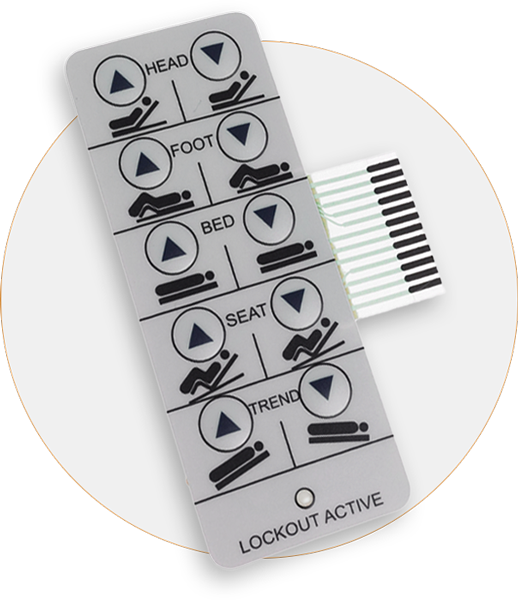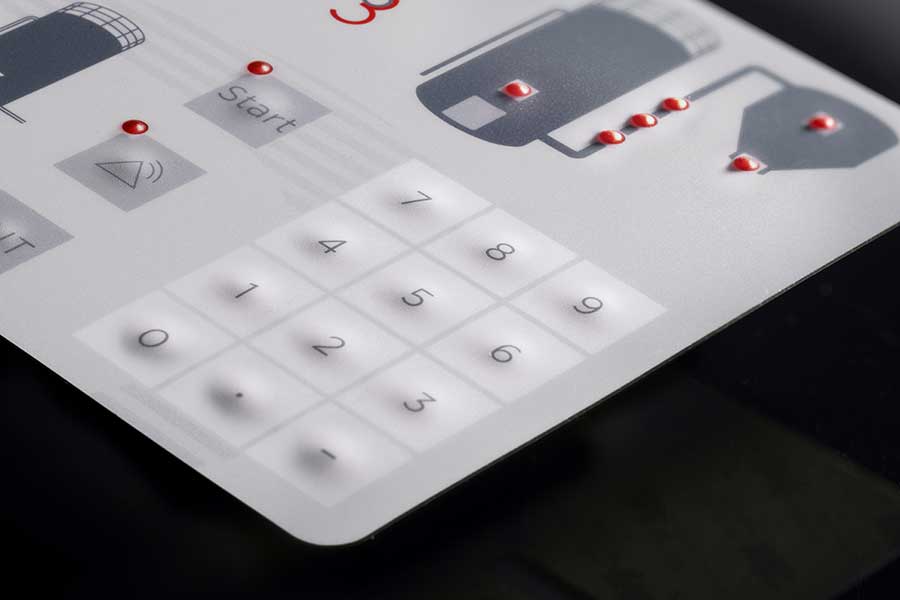Working with a qualified membrane switch manufacturer ensures compliance with industry standards.
Working with a qualified membrane switch manufacturer ensures compliance with industry standards.
Blog Article
All Regarding Membrane Switch: Understanding Its Design and Functionality
When you consider the control user interfaces in modern-day devices, membrane layer switches frequently come to mind. These elements are a lot more than simply buttons; they blend layout and capability seamlessly. Recognizing just how they work and what makes them efficient can change your viewpoint on day-to-day electronic devices. There are nuances to their design and efficiency that you might not be aware of. Let's discover what collections membrane changes in addition to other control systems.
What Are Membrane Buttons?

Membrane layer buttons can also be personalized concerning shape, dimension, and graphics, permitting manufacturers to create distinct user interfaces customized to specific products. On the whole, membrane layer buttons play a substantial function in improving individual experience throughout a large variety of applications.
Just How Membrane Changes Job
When you push a key on a membrane layer button, it turns on an uncomplicated yet effective device. The leading layer, commonly made from versatile material, lowers onto a conductive layer beneath it. This action bridges the void between conductive traces, completing an electric circuit. As quickly as the circuit shuts, it sends a signal to the gadget's controller, which interprets your input.
You'll discover that the tactile responses differs based on the button design, using either a soft click or an extra noticable feedback. As soon as you release the secret, the membrane returns to its original setting, resuming the circuit and quiting the signal. This process takes place virtually immediately, ensuring a responsive customer experience.
Membrane switches are popular as a result of their sturdiness and resistance to dirt and wetness, making them suitable for various applications, from family appliances to medical devices. Understanding this procedure helps you appreciate their prevalent use.
Secret Elements of Membrane Buttons
Recognizing the key components of membrane layer buttons is essential for realizing their capability and design. At the core, you'll locate the visuals overlay, which provides the visual user interface for users. Underneath that, there's a spacer layer that separates the circuit layers, making certain that they do not make call up until pressed. The circuit layer is where the magic takes place; it includes conductive traces that complete the circuit when you push the button. Another necessary component is the sticky backing, enabling the button to stick to surfaces firmly. Lastly, the safety layer shields versus ecological factors and wear, prolonging the button's life expectancy. Each element plays a considerable function in making sure dependable efficiency and customer communication. By recognizing these elements, you'll acquire insight into just how membrane layer changes run and their relevance in different applications.
Materials Made Use Of in Membrane Switch Over Design
The efficiency and durability of membrane switches over heavily depend on the materials made use of in their style. You normally run into polyester and polycarbonate as main substrates due to their superb stamina and flexibility. These products withstand scratches and chemicals, making them optimal for demanding settings.
The conductive layers usually make use of silver or carbon, selected for their integrity and conductivity. membrane switch manufacturer. Silver gives remarkable efficiency, while carbon is an affordable alternative. For the overlay, you could consider a matte or glossy finish, relying on your visual needs and user experience
Make click this site particular to choose adhesives that stand up to environmental variables like temperature level and humidity. Selecting the best products will certainly guarantee your membrane layer switch stands the examination of time.
Style Considerations for Membrane Switches
While making membrane buttons, it's vital to take into account different variables that affect their functionality and individual experience. Start by concentrating on the layout and button dimension; make specific they're user-friendly and simple to navigate.
Verify your style fits environmental variables, like moisture or temperature level variations, which might influence efficiency. By carefully taking into consideration these aspects, you'll produce a membrane button that improves functionality and contentment.
Applications of Membrane Switches
Membrane switches are functional elements discovered in numerous applications, from commercial equipment to customer electronic devices. You'll see their impact in machines that call for long lasting interfaces and in gadgets that benefit from smooth layouts. Recognizing these applications assists you value the capability and practicality of membrane layer switches in day-to-day technology.
Industrial Devices Use
When you're looking to enhance the capability of commercial devices, membrane layer switches use a trusted solution that incorporates longevity with user-friendly design. These buttons are excellent for severe settings, supplying resistance to dust, dampness, and chemicals. You'll locate them in control panels for manufacturing makers, a/c systems, and clinical devices, where accuracy and responsiveness are essential. Their low profile means they fit effortlessly right into different devices, saving valuable space while keeping simplicity of usage. With personalized graphics and backlighting options, you can produce an intuitive user interface for operators, improving performance and security. And also, their long life expectancy reduces upkeep costs, making them a smart investment for your industrial applications. Welcome membrane layer buttons to enhance your operations and enhance overall efficiency.
Customer Electronic Devices Combination
In the domain name of customer electronic devices, membrane switches play an essential duty in boosting individual communication and gadget functionality. Membrane buttons also guarantee toughness and resistance to dirt and moisture, prolonging the life expectancy of your electronics. By selecting membrane buttons, you enhance not just the functionality yet other likewise the design of your tools, making day-to-day interactions smooth and pleasurable.
Advantages and Disadvantages of Membrane Layer Buttons
While membrane switches supply a variety of benefits, they also come with some downsides that you must consider. One considerable benefit is their compact layout, making them ideal for space-constrained applications.

Membrane layer switches can have a much shorter life-span compared to mechanical recommended you read buttons, especially under heavy use. They can also be much less responsive, which may influence customer feedback throughout procedure. Stabilizing these pros and cons will certainly assist you identify if membrane switches are the appropriate fit for your task.
Regularly Asked Concerns
How Much Time Do Membrane Switches Typically Last?
Membrane layer switches over generally last between 5 to one decade, depending upon usage and environmental conditions. You'll wish to review elements like wear, direct exposure to moisture, and temperature variations to evaluate their durability successfully.
Can Membrane Changes Be Personalized for Particular Designs?
Yes, you can tailor membrane switches to fit particular layouts (membrane switch manufacturer). You'll have the freedom to select shades, shapes, and designs that match your job's needs, ensuring they mix perfectly with your general visual
What Is the Expense Array for Membrane Layer Change Manufacturing?
The price array for membrane layer button manufacturing usually falls in between $1 and $10 per system, depending on elements like layout intricacy, amount, and products. You can get quotes from manufacturers to discover the very best option.

Are Membrane Layer Switches Water-proof or Immune?
Membrane layer switches can be created to be water resistant or resistant, relying on materials used and construction approaches. If you need them for wet atmospheres, ensure you specify those requirements during the style procedure.
Just How Do Membrane Switches Over Compare to Conventional Buttons?
Membrane buttons are generally thinner and a lot more flexible than traditional buttons, using a streamlined layout. They're typically much easier to cleanse and integrate, but might not give the responsive responses you're utilized to with mechanical alternatives.
Final thought

Report this page